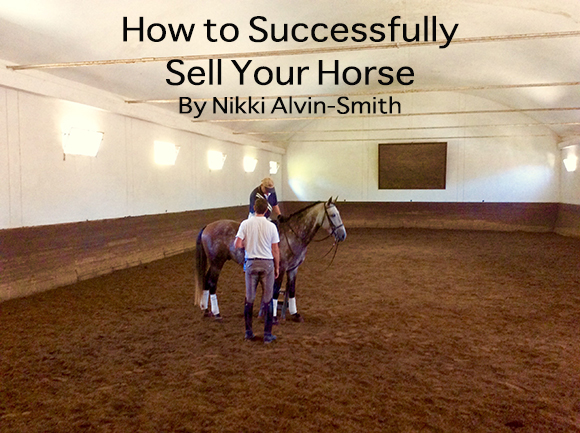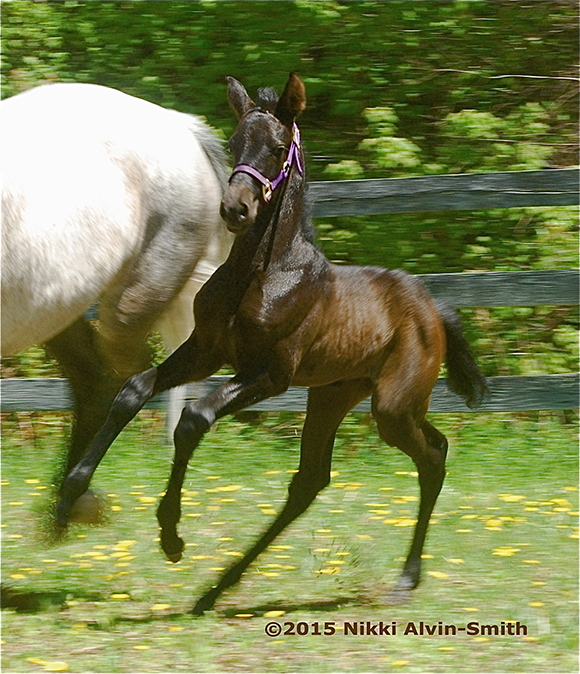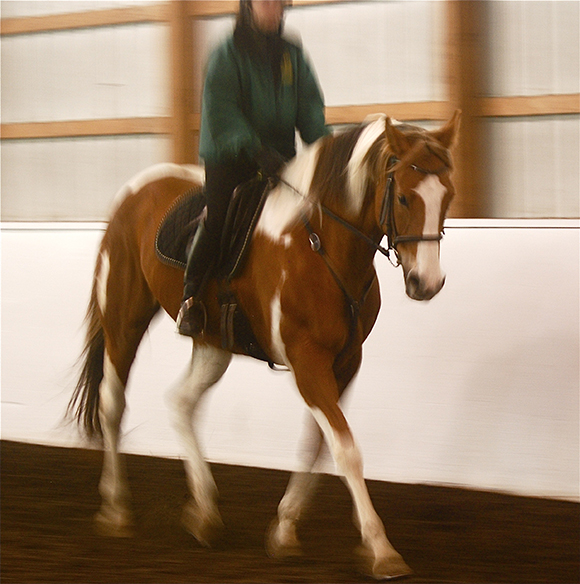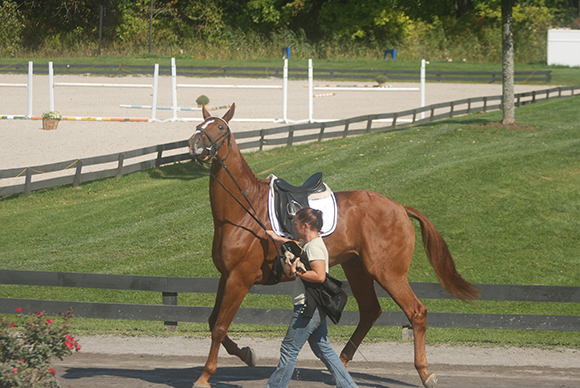How to Successfully Sell Your Horse
By Nikki Alvin-Smith

There are a myriad of reasons why people sell horses. Horse breeders regularly have stock for sale; you may have outgrown your horse or he may be too much for you; simple economics force a sale; your needs have changed as you cross disciplines. Whatever the reason, the successful outcome for any horse sale is finding a great new partner for your equine and realizing a price you can accept happily.
The first step is to take an objective and realistic look at the attributes your horse possesses. If your sale is to succeed, it is important to be honest about your horse.
There is zero point in falsely claiming his age, height, or build. These tangible attributes will be easily discovered so why waste both your time and the prospective buyer’s time by telling falsehoods. It will create immediate distrust on their arrival when they meet the horse and they will throw everything else you’ve said into the fire of disbelief.
An objective eye must be cast over your horse to illuminate his talents and weaknesses. In marketing it is important to push what is unique about the item you are trying to sell to make it stand out from the competition. This is called a unique selling point (USP). For example, your dressage horse may have won his first classes off the farm with grand scores of over 75%, he may have full siblings that have excelled in the dressage world and may match their phenotype and well as genotype making him a hot prospect even if he has little proven experience in the ring. It is not always easy to figure out the USP and consultation with your trainer or horse friends/family that are familiar with your beast may be helpful in nailing down which feature you wish to push hardest.
When advertising your horse it is important that you have more than just a social media presence that people can refer to if they are interested in learning more about him. Facebook pages are a wonderful tool to use to help reach more audience and photos and videos posted on Pinterest, YouTube and other sites can be useful to draw people’s interest, but you need to have a place to send them aferward. That place most assuredly should be your own website. For little to zero expense you can easily create a website on Wordpress if you don’t already have one. This is where you can create trust through branding. The website should be littered with fantastic photos of your horse. These photos should showcase the horse successfully completing the activity for which you are chiefly marketing him. Which brings us to the second step to consider in your sales effort, your target audience.
The audience for your horse or pony will be specific. For example, if you have a horse that just completed a Training Level eventing course, and the horse is extremely forward and loves to run and jump, then the eventing market is obviously the choice for him. If you have a trail horse that is reasonably sound but could not withstand ring work with circle after circle, jump fences or become a performance horse, do not panic. In my thirty years plus experience I have learned that for every horse there is a rider. I have also learned that despite my own education and talent level I am not the best home for every horse. Knowledge of your target market will affect where you advertise and obviously what price your horse may command.
Price is necessarily another important factor in the sale of your horse. My son, who is a litigator once told me, “ A good settlement is where neither party walks away completely happy.” That is to say, there has been some compromise. If you are not sure how to price your horse then you can consult an equine appraiser or talk to your trainer for input and do your own market research and see how other horses of similar training/talent/bloodlines are priced. Be aware just because a horse is priced at a certain point does not mean it sold or will sell for that price. Be prepared to be flexible on price when you find the right rider match for your horse.
When advertising your horse it is important not to overwhelm the prospective buyer with every little detail about your horse. You want to leave questions in their minds to encourage them to seek you out. Your website should have clear contact information.
Make Photos and Videos Count
In today’s world everyone wants to see a video. I have done some informal surveys of my own and asked how long ideally a video clip should be and what the buyer would like to see covered.
Most buyers answered that three to six minutes was enough video time because any longer they considered a waste of their time when they searched online. Obviously whatever job the horse was being advertised at being competent doing or excelling at needed to be the start of the video but buyers were also interested in seeing the horse stood up in profile and from front to back, and walked and trotted in hand to and from the camera. When asked about seeing the horse on the longe line too, most said they didn’t care because if a horse was under saddle then they assume it can longe.
If you are selling a foal, young horse or breeding stock then obviously work at liberty should be included in the video.

The rule with photos in advertising is clear-cut. Use one super good photo rather than a bevy of photos. You can use more photos on your website but multiple photos for advertising isn’t needed. When advertising if you do any display advertising remember frequency of advertising is more important than size of the advertisement.
Here are several tips to help you when producing your video or taking photographs:-
-
The horse should be clean and well groomed.
-
The handler/rider should be neatly dressed. Show clothes are not necessary just a tidy and professional experience.
-
Tack and equipment should be clean and in good order.
-
The background and general environment should be neat, tidy, horse safe and professional looking.
-
Your horse should be front and center in the shot. Do not have other horses in the background. Especially not horses that are more attractive or talented!
-
In video production short is sweet but do not leave the viewer feeling shortchanged. Include halt, walk, trot, canter both directions.
-
In videos showcase the horse successfully completing the job for which you are marketing him. For example: If he knows his 3rd level work well show him doing just that. If he has great form over fences showcase it.
-
Avoid adding music to the video as it is a distraction. Your taste in music may not match the viewers.
-
If there are distracting noises, comments then mute the video. However, many buyers like to be able to hear the horse’s breathing pattern and footfall.
-
Showcase your horse in the best environment possible. If you have no outdoor ring with decent footing consider taking the horse to a neighboring barn to take the footage. Horses always move better off the farm and on good footing as they have a little more excitement in their step. Obviously if your horse is green you may need to spend some time taking him offsite a few times first to settle, before you put him in front of the camera.
-
Ensure the video and photos are of good quality.
-
Website photos should include conformational shots.
-
Make sure your horse is sound. If he is not then find him the treatment he needs. If you know his soundness issues exist and need to be managed then be honest about that. Many riders accept that older horse or horses with mileage may need some medicinal or alternative therapy aid to keep them useful under saddle. There is little point in not being honest as it will come to light sooner or later. Your honesty will also pay dividends in later sales as your reputation as a seller will be enhanced.
You can utilize many avenues to market your horse both in print and online. Many sites online are free or offer relatively cheap upgrades for photos and video additions. If you are a member of a breed registry, USEF, USHSJA, USDF or USEA you may be able to utilize their marketing help. Always look at any memberships you have to see where you can increase your advertising coverage.
Once you have completed the above you should set a timeline for your advertising program. I generally run with a three month timeline before I re-evaluate the price, advertising content or reason for not having sold the horse. During this three months you have hopefully received many callers interested in your horse. How do you evaluate who is a true buyer and who is just wasting your time?

The True Buyer
Based on my many years of experience selling horses we have bred and horses we have imported for sale I have several tips to aid you in the diagnosis of whether someone is a true buyer:-
-
A true buyer will not be content with just the information on a video or website, they will want to chat with the seller. So beware of people that just email and say they want to come visit. I always make a point to interview prospective buyers on the phone by suggesting they contact me at their convenience. On the first phone call I ascertain their needs versus wants, riding experience and temperament. I find out who they train with if they have a trainer as I am particular about into whose hands my horses fall. Be frank and open about your horse. If you know it is not a good fit there is little point in not saying so as to do otherwise simply wastes time. Over the years I have had many riders contact me more than once telling me my honesty was helpful and they are grateful, and they call me when they are again in the market and ask if I presently have anything more suitable. They will also refer friends. I also try to have a second telephone conversation whenever possible, by suggesting they think about our conversation and then call me back if they feel they’d like to visit the horse. People that are not being honest are usually prone to being caught in a lie during round two of the telephone conversation as they forget what they have claimed or said. It is a good idea to make notes on buyers as they call as well as taking down phone numbers/emails for future use.
-
A true buyer will ask many questions and not just cursory questions. They will be interested in the history of the horse; where you bought him; his medical history and condition; his quirks and foibles; and his general nature and disposition in addition to his showcased talent under saddle. A true buyer wants to learn as much as possible about the horse before contemplating the purchase.
-
The video hound. These are the buyers who have seen a perfectly complete video and always want more. In my experience sending more and more video footage is usually a waste of time. I may compromise if the rider is a professional or lives a long way away, but in general the video hound is not a true buyer. True buyers do not want to waste time and miss the opportunity to buy a horse they are seriously interested in viewing.
-
A true buyer will not compromise. Most riders (though not all) are well aware of what their requirements and needs are in their prospective new equine partner. Some of these needs may be unrealistic and they may need to be nudged into the right direction. For example, the buyer wants a two year old warmblood that is walk, trot and canter and ready to do Training Level. Obviously this is a ridiculous ask so as a warmblood breeder I will educate them. As a seller you can gently explain and educate the buyer in certain aspects but overall I avoid trying to change the buyer’s mind on their criteria. They will always have doubts on the horse if their original criteria are not met. I have even had people turn down a wonderful horse that totally suited their riding style, temperament and level because it was not the right color. Yes it was a dark bay but not dark enough. What??? There is no accounting for what goes on in some buyer’s heads and the best thing to do is to simply move on as politely as possible.
-
A true buyer will not ride the horse if there is no real interest. It is particularly difficult when marketing an advanced horse to protect your horse from the zealous riders who seek to try every horse in sight just to say they have ridden a horse at that level. Remember you are your horse’s last defense. If a buyer comes to try a horse and I do not believe it is safe, prudent for their or the horse’s well-being for them to ride it I have no qualms saying just that. I have kicked people off horses who start over-facing or trying to ‘train’ the horse past where it is currently working. Even if those riders are big name riders! When you are honest about your horse’s level and ability, the true buyer will ask to see the horse ridden and will not ride the horse just for the sake of it. If they mount the horse they should be polite and ride each gait in each direction. If the horse has a talent to jump, drive or perform at a certain level in any discipline the buyer should be able to exact that performance level on the horse or get somewhere close to it if it is a horse they are to grow into. Do not allow buyers to override the horse, challenge the horse or otherwise cause upset. You will be left with the bad result and you do not want your horse spoiled.
Commissions
Trainers may charge their clients a commission or search fee for finding a horse. Professionals are generally up front about this and these fees are not the responsibility of the seller. If you decide to sell your horse through your trainer be aware that your trainer will probably charge you a commission off the selling price. My advice is to get any commission fees for which you are responsible in writing, so as not to cause confusion on terms later.

My Horse Didn’t Sell
The fact your horse didn’t sell can be for a variety of reasons. If people came to try him think back on their comments and see if there was a common thread of discontent. They may not have directly mentioned anything as a good buyer will simply tell you the horse is not a good fit to save your feelings. However you will have seen how the horse responded to the visiting riders and their trainers and it may be that your horse simply needs either more training or more correct training. You may decide it is worth investing in more training help to keep your price or you may decide to lower your price to reflect what the market is telling you.
Is your horse one hundred percent sound? If he is not and if somehow they didn’t see this on the video then maybe they felt it under saddle or maybe he has become unsound during the marketing timeframe. Horses are just like us, if they hurt somewhere they become tired and grumpy and resist doing those things that cause them pain.
When you find the right match for your horse, and you will, there is no finer feeling. You know that the horse will go on to have a happy life with his new person and that you have done them both good service. As the German team dressage rider Gabriella Grillo once said to me, “ This horse did not ask to come into my yard, I brought him here. It is up to me to treat him with kindly and with respect.” I feel the same when they leave my care. You will never regret taking the care to find the right match.
Good Luck and Happy Riding!
About the author: Nikki Alvin-Smith is an international Grand Prix dressage trainer/clinician who has competed in Europe at the Grand Prix level earning scores of over 72%. Together with her husband Paul, who is also a Grand Prix rider, they operate a private horse breeding/training farm in Stamford, NY.


